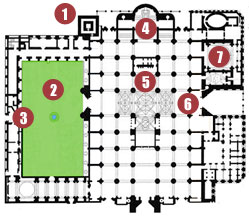 Concieved on a magnificent scale by the Canons of Seville as far back as 1401, the Cathedral of Seville is still today the largest church in Europe. It doesn´t fail to impress and not just by it's sheer size - the main nave rises to a dizzying 42 meters. There is a wealth of art contained within, not least the fabulous Main Altar and though principally gothic, there are also some Islamic architectural elements. Though the main Mosque of the Almohads was demolished to make way for it, features remain. Some are obvious - the Giralda tower, for example, but some are less so. The ground plan of the Cathedral follows that of the Mosque's - a rectangle rather than a cross - and this explains the rather unusual positioning of the entrances.
Concieved on a magnificent scale by the Canons of Seville as far back as 1401, the Cathedral of Seville is still today the largest church in Europe. It doesn´t fail to impress and not just by it's sheer size - the main nave rises to a dizzying 42 meters. There is a wealth of art contained within, not least the fabulous Main Altar and though principally gothic, there are also some Islamic architectural elements. Though the main Mosque of the Almohads was demolished to make way for it, features remain. Some are obvious - the Giralda tower, for example, but some are less so. The ground plan of the Cathedral follows that of the Mosque's - a rectangle rather than a cross - and this explains the rather unusual positioning of the entrances.
 Giralda Tower
Giralda Tower
Originally the minaret of the main Mosque dating from 1172-1198. Very similar is the Kutubyya in Marrakech. The upper section housing the bells and crowned with the statue of Faith - or the Giraldillo - dates from the 16th century.
 Patio de los Naranjos
Patio de los Naranjos
The courtyard or sahn of the original mosque. It was remodelled considerably in the 13th century for use as a cloister and cementary. Today it has more or less regained it's original form (though not, alas the decoration), after restoration in the 20th century.
 Puerta del Perdón
Puerta del Perdón
Once the main entrance to the mosque, it lined up with the mihrab or prayer niche which indicated (erroneously in this case!) the direction of prayer towards Mecca. Like the Giralda, it was remodelled in the 16th century to include a belltower and terracotta sculpture but still retains it's original horseshoe arch and decoration and elaborate doors.
 Capilla Real
Capilla Real
Normally in a gothic Cathedral one would expect an apse with an ambulatory at the eastern end. In Seville we find the Royal Chapel - the final resting place of members of Spanish Royalty. Among others are Alfonso X and Pedro I, known as the Cruel, who built the Alcázar.
 Altar Mayor
Altar Mayor
The Main Altar is dwarfed by the golden splendour that is the main altarpiece. Carved and polychromed, it was begun by flemish craftsmen in 1482 and it took almost a century to complete. Comprising hundreds of figures and depicting scenes of the life of Christ as well as of the City and Cathedral, it is a stunning example of its kind.
 Monumento de Colón
Monumento de Colón
The Tomb (or Monument) to Christopher Columbus is situated near the Capilla Antigua (or Ancient Chapel) where Columbus is said to have prayed before his voyages and perhaps named the island of Antigua after. It has long been claimed that the bones held within belong to the explorer, though this was hotly contested by the Dominican Republic. The remains were brought back from the island in 1899. In 2006 analysis proved that the DNA was the same as that of his brother Diego's, also buried in Seville.
 Sacristía Mayor
Sacristía Mayor
The Sacristy is the first of the Renaissance additions to the Cathedral dating from 1530-1543. Stylistically a total contrast to the main body of the Cathedral, it stands out with its lovely dome, pale stone, and rich carving. It houses the Treasury which includes works by Goya, Murillo and Zurbaran; as well as numerous sculptures and a plethora of reliquaries. The Treasury also holds the Keys to the City, presented to Ferdinand by the Jewish and Moorish communities at the surrender of the city in 1248.